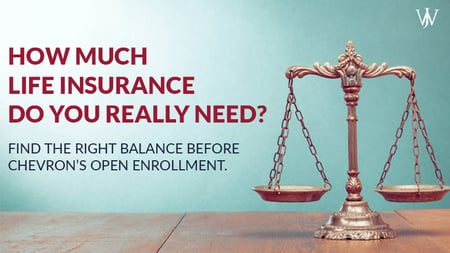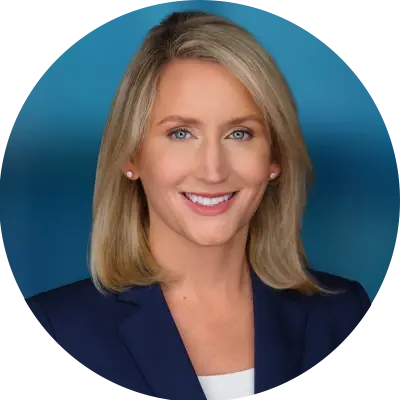Every Open Enrollment season, we sit down with our Chevron clients to discuss the Chevron Life Insurance plans to assess the right elections to make for the coming year as part of our proactive financial approach. While thinking about what happens if you pass away is never a cheery conversation, knowing that your loved ones are taken care of in various circumstances is an important discussion worth having. Whether you’re out on a rig, traveling the globe, or working behind a desk, having the right amount of insurance to cover you and your family’s needs can offer you peace of mind for whatever life throws at you. In this article, we’ll look at each plan from a high level, who it’s right for, and what’s covered so you have a better understanding of your options. Let’s get started.
Chevron Group Life Insurance Options
Chevron offers its employees 3 different types of life insurance coverages at various costs:
- Basic Life Insurance
- Supplemental Life Insurance
- Dependent Life Insurance
Basic Life Insurance
All full-time employees at Chevron are automatically enrolled in Basic Coverage at no cost. This basic coverage, underwritten by MetLife, provides a lump sum benefit at the time of an employee’s death equal to two times your annual base pay. For example, if you make $150,000 a year, your basic life insurance coverage policy provides a $300,000 benefit if you pass away. The basic plan doesn’t cover dependents (we’ll get to that shortly), but it does include funeral planning services and grief counseling benefits as part of its coverage.
Supplemental Life Insurance
If you want additional coverage for yourself beyond what is automatically provided by Chevron under the Basic Life Insurance policy, you may enroll in the Supplemental Life Insurance Plan. By enrolling in the supplemental plan, you cover all costs and can purchase coverage for up to an additional 8 times your annual pay.
For example, let’s say you make $150,000 annually. The Basic Life Insurance Coverage would provide up to $300,000 in benefits if you passed away. The maximum amount of Supplemental Life Insurance you can purchase is $1,200,000 (8 * $150,000) for a total Life Insurance Coverage of $1,500,000 ($300,000 + $1,200,000).
In total, the combined maximum amount of coverage Chevron allows under their Basic & Supplemental Life Insurance Plans is $10 million. Additionally, this supplemental life insurance coverage is portable, which means that you can take it with you if you leave Chevron or retire.
Dependent Life Insurance
You may be asking, “But what about coverage for my partner or my children?” While they aren’t covered under the two plans above, Chevron offers a third plan so your loved ones aren’t excluded from coverage. Chevron’s Dependent Life Insurance Plan permits you to purchase life insurance coverage for your eligible dependents, including your spouse or domestic partner, or children (under age 25).
Similar to the Supplemental plan, the coverage is optional so you must enroll if you want to participate. You can cover an eligible spouse or domestic partner in $10,000 increments from $10,000 to $250,000. If you choose to also cover eligible children dependents, you can elect for either $10,000 or $20,000 of coverage, which automatically covers all of your eligible children (under age 25).
If you choose to enroll in the dependent life insurance plan, you’ll pay the full cost of coverage at group rates. It bears repeating that the costs for these plans can change over time, which is why it’s so important to review them every year during Open Enrollment. While Chevron can offer group rates for coverage, evaluating your options in the market may make more financial sense for your family’s needs, especially if you need more or less coverage than Chevron’s plans offer.
Chevron’s Group Life Insurance or Term Insurance: Which is Right for You?
During Open Enrollment, many assume the best choice for life insurance is going through the options Chevron offers. But, is it? There are benefits to going through Chevron’s program for group rates, however, for some, it may be better to purchase your own term insurance instead. One of the key considerations we look at with our Chevron clients is the cost of these plans. Because of Chevron’s size as an organization, they can get attractive group plan costs at lower rates than what you may find in the open market. Chevron offers a handful of options to consider rather than having an overwhelming amount of choices, and these policies are portable if you choose to leave Chevron or retire.
If, however, you’re extremely healthy for your age group, you may be able to purchase a cheaper term policy than what’s offered through Chevron and find one more customized to your needs in the open market.
How Much Life Insurance Do You Need?
A common question we get from our Chevron clients is how much life insurance to purchase once they’ve decided they need it. We typically look at life insurance as “human capital replacement” or the cost of replacing the income you’re currently earning.
Let‘s consider a simple example. If Bill, a 45-year-old Chevron employee, earns $200,000 a year as a single-income household and is planning to work for another 15 years, how much life insurance would he need?
To replace his projected future earnings (“human capital”), we’d say that $3,000,000 of life insurance would be a good place to start since it’s replacing $200,000 of income * 15 years. However, this is a very simple example and doesn’t take into account any of Bill’s retirement savings, investment growth, or financial goals, all of which could impact the amount of insurance he’d actually want to have. For employees like Bill who aren’t financially independent yet, life insurance can be an important opportunity to leverage within a financial plan to protect a family’s cash reserves in the event of an unexpected passing.
Let’s consider another simple example we see with many of our Chevron clients. If Julie, age 63, is nearing her retirement from Chevron and evaluating how much life insurance she should purchase, it’s a very different story from Bill. We don’t need to replace as much of her projected human capital because she’s only planning to work for a few more years. Instead, we’d focus on what her retirement benefits and savings offer her to live off of. The two keywords we’re looking to address in this scenario are: Financial Independence. If Julie is anticipating a substantial CRP & RRP payout, has been an effective saver in her ESIP 401(k), and will be financially independent when she leaves Chevron, she may need very little or no life insurance at all.
There are a number of factors that go into determining the right amount of life insurance to buy. In fact, it’s a bit like Goldilocks – you don’t want to have too little in case you need it or too much where you’re overpaying for unnecessary coverage. It needs to be just right for your stage of life, what you have, and your financial goals.
Work with a Fiduciary Financial Advisor to Assess Your Insurance Needs
Insurance is an important part of financial planning, and making the proper elections for coverage during your Annual Enrollment period is crucial. At Willis Johnson and Associates, we believe that insurance should be part of a comprehensive financial plan. Our firm focuses on comprehensive financial planning and ensuring that strategies like evaluating insurance gaps are correctly executed to help our clients reach their financial goals. We work with our clients to assess their individual needs and goals, and then develop a customized plan that includes insurance as one of the key components.
The right amount of insurance coverage can help protect you from financial loss in the event of an unexpected event, such as a death or an unforeseen illness. Unlike other firms, we don't sell insurance, so we can focus on finding the right plans and amounts needed for our clients without any conflicts of interest. As a Registered Investment Advisory firm (RIA), we're held to the fiduciary standard to work in our client's best interest and make insurance recommendations based on individual needs and goals, not for commissions or trail-end compensation.
At WJA, we look at all your financial pieces to ensure nothing gets overlooked or left on the table. Working with a financial advisor is a beneficial way to determine if this or other tax-efficient savings strategies can help you reach your long-term goals. Start the conversation with an advisor today.








